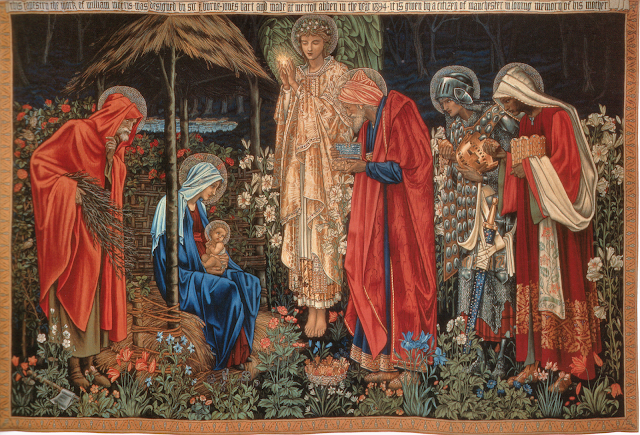Epiphany
Scripture: Epiphany,
A.D. 2016 C
Homily:
Grace, mercy and peace to you from God our Father and from
our Lord and Savior Jesus Christ. Amen.
The great holidays of the Christian year, as well we know, are
Christmas and Easter. Christmas celebrates the birth of our Lord and Savior,
the Incarnation come forth from Mary’s womb for the salvation of the world. Easter
celebrates our Lord’s second birth, His Resurrection, shattering the gates of
hell and rising triumphant from the sealed tomb.
Bridging the gap between these two—betwixt birth and death,
Incarnation and Resurrection—is this season of Epiphany, the season of God’s “manifestation”
among us in the life and teachings of Jesus Christ. For indeed that’s what
Epiphany means: manifestation. And in this season we contemplate the Adoration
of the Magi, the Baptism of Our Lord, the Wedding at Cana, and all the ways
that God has made His power and mercy and grace manifest as He walks among us
in the flesh.
Faithfully have we celebrated for 12 days the birth of our Messiah.
Now is the time for us to contemplate the mystery and the wonder of exactly who
and what He is.
We begin, quite naturally, with the Magi: those Wise Men
from the East, who arrived shortly after the Nativity of Our Lord, in order to
adore the Christchild whose coming was foretold of old and heralded in the
heavens, and to offer Him their famous gifts of gold and frankincense and
myrrh. Isaiah, who prophesied so clearly and faithfully about the coming
Messiah, foretold that camels from Midian and Ephah and Sheba would bear gifts
of incense and gold to the risen Light of Israel. All three of those nations mentioned
were Arab tribes, children of Abraham related to Israel, and all well aware of
Balaam’s prophecy that a Star would herald the birth of the great King.
The inclusion of Sheba in the prophecy proves especially
interesting, given that it was the Queen of Sheba who long ago had sought out
the wisdom of Solomon, and whose country had a near monopoly on frankincense. If
you’ve ever wondered why the Magi are depicted as Three Kings on camelback from
three separate nations, now you know. Incidentally, the people of Sheba were
known for darker skin, as indeed one of the Magi is usually depicted.
Some disagree, mind you. Some believe that the Wise Men
heralded from the ancient empire of Persia. The Persians too were well
acquainted with the Jewish people, and stargazing Persian priests indeed were known
as Magi. Not that it particularly matters. Wherever they came from, whether
they were chieftains or priests or ambassadors, what’s important about the Wise
Men is whom they represent—for in truth the Magi represent us all.
They represent all the outsiders, all the pagan nations,
searching for truth, scouring the heavens, seeking light from the East. Christ
is born not for one people but for all people. He is both the glory of His
people Israel, and also the promised Light to reveal God to the nations. And wise
men of every time and place shall seek Him out, shall be drawn to His light,
from the far corners of the earth. In works of art, the Magi are traditionally
represented as Three Kings from the three known continents of the ancient
world: Africa, Europe, and Asia. And they are depicted at the three stages of
life: youth, maturity, and old age. This stresses how we are all Magi, all
outsiders drawn to Jesus, no matter our origins or age.
Now, about those gifts. We couldn’t overlook those, could
we? Gold has ever been considered the perfect metal, glowing luminously as the
sun, impervious to rust or decay. Gold holds universal value, coveted by rulers
and nobility. Gold is the gift of kings, and here it is offered to the King of
Kings. Frankincense is held as the finest of fragrances, not simply elegant but
divine. For Gentiles and Jews alike, frankincense is the fragrance of worship,
a burnt offering to the gods. To give frankincense to the Christ is to
acknowledge His divinity.
And then the myrrh. What a peculiar gift for a young Child.
Worthy, certainly—myrrh at the time was worth seven times its weight in gold.
But despite its dubious use in seductions, myrrh is an incense most associated
with death. Romans threw handfuls of myrrh onto funeral pyres to mask the
stench of cremation. Judeans dissolved it in oil to anoint the dead for burial.
Myrrh is a prophecy of death. The Christchild is destined to die. Just as the
Christmas tree prefigures the Cross, and the cave in Bethlehem foretells a tomb
in Jerusalem, so the shadow of Good Friday extends even over the starry light
of the Epiphany.
Thus does that most famous hymn of the Three Kings prove
cannily accurate: Glorious now behold Him
arise / King and God and Sacrifice.
The Christ has come among us. Our God is here in the flesh.
In this season of transition, this season of wonder, let us seek Him out to
offer what gifts we have, and to lay ourselves prostrate before Him in
awestruck adoration.
In the Name of the Father and of the +Son and of the Holy
Spirit. Amen.

Comments
Post a Comment